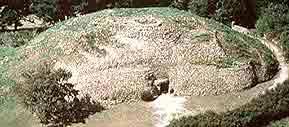- Home
- Megalithism in Morbihan
- Architectural types
- Mausoleums
- Milestones
The Er-Grah Tumulus at Locmariaquer with its primary cairn surrounding the tomb with a heap of stones and its secondary cairn made of loam.
The Gavrinis cairn, the facade of which was revealed during the excavation of the sand and stone mound sealing the tomb.
The Petit-Mont cairn at Arzon, with many faces forming concentric scales.
With the exception of a few special cases, a megalithic tomb looks like a simple, not very stable, group of outcrop blocks standing on a shapeless mound, which may sometimes not even be noticeable.
However, every time serious excavations have been carried out, they have revealed at least the bases of complex structures which enrich and complete this framework.
The terraced cairn is the most common structure in Brittany.
It is a heap of stones structured by faces, one on top of another, some of which may be relatively high (up to 10m). Traditionally, in Brittany the stones form concentric scales.
A mound is a similar type of monument, but this time mainly made of earth.
It can be structured by faces (as at Dissignac), or by an internal wooden framework (Er-Grah at Locmariaquer).
A tumulus is a Latin word which implies the idea of "tumulation", i.e. closing of the tomb. In order to avoid confusion, this word is to be used only when the mausoleum really seals the tomb(s) it covers. The sealing may be later than the mausoleum itself (for instance at Gavrinis).
These megalithic mausoleums sometimes represent a substantial volume (30 000m3 for the Saint-Michel tumulus in Carnac). In the larger monuments, volume is not related to the crypts they cover (usually only a few dozen cubic meters).
Similar tombs can be found under very different monuments, as if the functions related to monumentalism had been very important on some sites but minor on others.
However, very large mausoleums only cover archaic tombs (cists or simple passage chambers). More complex tombs are covered by smaller architectures, but the dichotomy between "large" and "small" monuments is still noticeable until the Late Neolithic.
Some monuments have no internal funeral structure (Bilgroix, Petit-Mont I). This does not necessarily make them cenotaphs, as they may have had superstructures (possibly made up perishable materials), related to various activities not necessarily connected with funeral cults.


